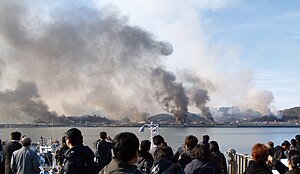Shelling of Yeonpyeong
| Bombardment of Yeonpyeong | |||||||
|---|---|---|---|---|---|---|---|
| Part of the inter-Korean Conflict | |||||||
 Yeonpyeong Island under North Korean artillery attack |
|||||||
|
|||||||
| Belligerents | |||||||
|
|
Supported by: |
||||||
| Commanders and leaders | |||||||
|
Kim Jong-il VMAR. Ri Yong-ho Col. Kim Kyong Su |
Lee Myung-bak | ||||||
| Strength | |||||||
| One battalion BM-21 Five MiG-23s |
Six K-9 Thunder SPGs Four F-15Es Four F-16Cs |
||||||
| Casualties and losses | |||||||
|
South Korean claim: 5–10 killed and 30 wounded North Korean claim: At least 5 |
2 soldiers killed 19 soldiers wounded 2 civilians killed 3 civilians wounded Two K-9s damaged |
||||||
Coordinates: 37°40′0″N 125°41′47″E / 37.66667°N 125.69639°E
The bombardment of Yeonpyeong was an artillery engagement between the North Korean military and South Korean forces stationed on Yeonpyeong Island on 23 November 2010. Following a South Korean artillery exercise in waters in the south, North Korean forces fired around 170 artillery shells and rockets at Yeonpyeong Island, hitting both military and civilian targets.
The shelling caused widespread damage on the island, killing four South Koreans and injuring 19. South Korea retaliated by shelling North Korean gun positions. The North Koreans subsequently stated that they had responded to South Korean shells being fired into North Korean territorial waters.
The incident caused an escalation of tension on the Korean Peninsula and prompted widespread international condemnation of the North's actions. The United Nations declared it to be one of the most serious incidents since the end of the Korean War, and by December 18, former UN ambassador Bill Richardson said tensions had escalated to become "the most serious crisis on the Korean peninsula since the 1953 armistice, which ended the Korean War".
...
Wikipedia
